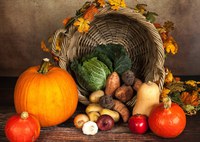Prairie Fare: Beets, Brussels sprouts and beyond — Giving veggies a second chance
(Click an image below to view a high-resolution image that can be downloaded)
“What’s your least favorite vegetable and why?” our produce safety workshop leader asked.
We were at the workshop to help people produce and process fresh fruits and vegetables safely, and we had a little fun with this icebreaker.
“My least favorite vegetable is beets, because they taste like dirt,” she added.
I have been asked about my favorite fruits, vegetables, soups, casseroles and other foods during icebreakers, but never my least favorite.
People began waxing on about their disdain for Brussels sprouts, broccoli, turnips, eggplants, rutabagas, mushrooms, hot peppers and avocados. Texture and flavor were the issues — bringing lots of laughs as they shared their polarizing views of vegetables.
I had to think hard to come up with a vegetable I don’t like. When I was young, we grew most of our vegetables. We ate the vegetables served in the bowls on the table, even Brussels sprouts and beets.
“My least favorite would have to be okra, because it is slimy, but I had breaded, deep-fried okra and that was pretty good,” I noted after pondering the question.
Breading and deep-frying makes almost anything pretty tasty but not necessarily health-promoting (that’s how I tried Florida alligator, by the way).
Okra is especially popular in Southern cuisine. It gets its texture from glycoproteins (literally “sugar-proteins”) that are “mucilaginous.” The soluble fiber is good for us, but it has a slimy mouthfeel. Some of the mucilage can be counteracted by soaking it in vinegar.
Is there a vegetable that you cannot tolerate for various reasons? Unfortunately, some people dislike vegetables entirely.
Nutrition experts recommend about 4 ½ cups of vegetables and fruits daily for kids and adults. That’s 2 ½ cups of vegetables and 2 cups of fruit, with whole fruit more valuable to our health than fruit juice. Most people do not reach this goal.
Remember that it can take 12 to 15 exposures to a food before people will accept it. In other words, you need to be patient.
While we may not have to like every type of food, sometimes the preparation method can help us overcome our dislike.
Most of us fall short of filling half of our plates with fruits and vegetables, which is the current recommendation. Try these ideas to explore more veggies:
- Get involved in gardening — even on a small-scale level, such as containers on a patio.
- Enjoy seasonal fruits and vegetables available in grocery stores.
- Visit a farmers market and interact with the growers who produced the food.
- Partake in a salad bar at a restaurant and set a goal to add something new to your plate — maybe pickled vegetables or chickpeas on top of your salad.
- Try serving “meals in a bowl.” Set up a buffet to enjoy taco bowls with plenty of lettuce, tomatoes and other veggies. See “Pinchin’ Pennie$ in the Kitchen: 5 Steps to Making Your Own Meal in a Bowl” from North Dakota State University Extension.
- Eat family-style meals or host a healthy potluck with your friends and family. Be good role models for each other.
- Don’t force people, especially kids, to try foods. That’s a surefire way to resistance.
- Experiment with different preparation methods for veggies, such as roasting, grilling or air-frying.
- See ag.ndsu.edu/fieldtofork for handouts, recipes and recorded webinars to learn more about fresh produce from apples to zucchini. The NDSU Extension handout “A Pocket Guide to Preparing Fruits and Vegetables” features numerous ways to enjoy fruits and vegetables.
Have you tried squash soup? This naturally sweet and savory soup will have your guests coming back for seconds.
Butternut Squash, Pumpkin and Apple Soup
1 pound butternut squash, peeled and cubed (about 4 heaping cups)
1 yellow onion, finely chopped
1 medium apple, cored and roughly chopped (such as Honeycrisp or Gala)
2 tablespoons olive oil, canola oil or favorite oil
1 teaspoon pumpkin pie spice (to taste preference)
1 teaspoon grated fresh ginger (or 1/4 teaspoon ground ginger)
1 teaspoon salt
1 (14.5-ounce) can pumpkin puree (not pie filling)
4 cups low-sodium vegetable broth (or chicken broth)
Preheat oven to 400 F. Cube butternut squash, onions and apple. Lightly coat them with oil, then roast in the oven for 8-10 minutes until softened. Transfer to a pot (or use a Dutch oven), then stir in pumpkin pie spice, ginger and salt; cook 1 minute. Add pumpkin puree and broth; stir well to combine. Bring the soup to a boil, reduce heat and simmer, covered, for 30 minutes. Squash should be fork-tender. Carefully transfer soup to a blender using a ladle, or use an immersion blender (if blender isn’t large enough to hold the entire batch of soup, blend in 2 separate batches). Secure lid on blender. Remove center piece of blender lid and place a clean kitchen towel over the opening to avoid splatters. Process soup until smooth, about 45 to 60 seconds. Divide soup evenly among bowls and top with garnishes of choice.
Croutons (prepare while soup simmers):
1 loaf sourdough or plain sandwich bread
Seasonings as desired (onion powder, garlic powder, etc.)
Preheat oven to 400 F. Cut bread into 1-inch squares and coat lightly with oil and season as desired. Place on sheet tray and bake until golden brown (5 to 7 minutes). Top soup with croutons.
Optional toppings: sour cream, pumpkin seeds, chopped pecans, fresh herbs (rosemary, thyme sage or basil)
Makes 12 servings. With croutons, each serving has 110 calories, 3 grams (g) fat, 2 g protein, 22 g carbohydrate, 5 g fiber and 390 milligrams sodium.
(Julie Garden-Robinson, Ph.D., R.D., L.R.D., is a North Dakota State University Extension food and nutrition specialist and professor in the Department of Health, Nutrition and Exercise Sciences.)
NDSU Agriculture Communication – Oct. 9, 2025
Source: Julie Garden-Robinson, 701-231-7187, julie.garden-robinson@ndsu.edu
Editor: Dominic Erickson, 701-231-5546, dominic.erickson@ndsu.edu




